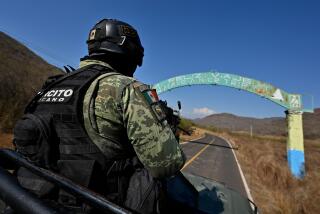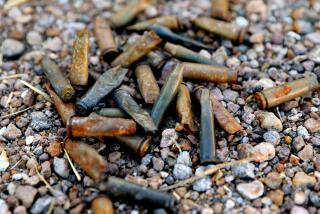Contras Plan to End Use of American Pilots
- Share via
SAN JOSE, Costa Rica — The recent loss of a C-123 cargo plane carrying guns and ammunition to guerrillas fighting in Nicaragua has forced the U.S.-backed contras to reconsider future plans for supplying arms by air to their troops in the field, rebel officials here say.
Moreover, a top contras leader said that no American pilots will be employed in the future to transport weapons and supplies.
The altered plans coincide with preparations to receive the first part of $100 million in new military and other aid from the United States. The increased assistance will require more numerous supply flights, and the rebels are moving to make them less vulnerable to anti-aircraft fire, they said.
Now More Vulnerable
Nicaragua’s Sandinista authorities consider air supply to be an Achilles heel of the contras’ military efforts, now that Managua’s surface-to-air missiles have proven to be effective. Such a missile, made by the Soviet Union, was used to shoot down the C-123 in southern Nicaragua on Oct. 5.
Rebel officials agree that their air supply operation is now more vulnerable, but they say that steps will be taken to evade Sandinista air defenses.
“We think that with more sophisticated equipment and altered routes, we can avoid similar problems,” said Alfonso Robelo, one of three directors of the United Nicaraguan Opposition, the rebels’ umbrella group.
Robelo estimated that 6,500 rebel troops are now fighting inside Nicaragua.
The United States has backed the insurgency on and off for five years. Recently, after prolonged efforts by the Reagan Administration, Congress for the first time appropriated funds specifically for military aid to the rebels, in contrast to either undercover help or the so-called non-lethal aid previously provided.
The new $100-million aid package lets the CIA once again undertake a role in managing the contras’ effort. In 1984, Congress had prohibited CIA involvement after it was disclosed that the intelligence agency was behind the mining of Nicaraguan harbors.
Robelo said that in the future, most supply flights will enter Nicaragua from the Caribbean, so that drops can be made over the sparsely settled eastern half of the country rather than near the Pacific Coast, where the bulk of the Sandinista army operates.
Flights may be made directly from the United States or from the Swan Islands, a group of tiny Caribbean isles that belong to Honduras, Robelo said.
Robelo added that speedboats will be used to take supplies ashore and that overland routes will be considered, despite the extra time that might be required to transport equipment across Nicaragua’s mountainous terrain.
“We may have to create our own Ho Chi Minh Trail,” Robelo said, referring to the land supply network in Vietnam used by Communist guerrillas fighting U.S. troops.
Flew From the South
The C-123 cargo flight shot down earlier this month had flown into Nicaragua from the south, after traveling down the Pacific Coast from El Salvador and turning eastward briefly over Costa Rica.
Two American citizens piloting the plane and a Nicaraguan rebel radio operator died in the incident. A third American, Eugene Hasenfus, parachuted to safety and was captured Oct. 6 by Sandinista troops. Hasenfus, a cargo handler on the flight, is on trial in Managua for war crimes. The Reagan Administration denied any official U.S. connection with the flight.
“It was a tough blow, no doubt about that,” Robelo said about the loss of the plane and crew. “The route the plane took made it vulnerable.”
The revelation that private American pilots were working for the contras pointed up the scarcity of Nicaraguan rebel pilots willing to make the risky flights into Nicaraguan airspace. Last year, a Nicaraguan pilot was killed making a rebel transport run over Nicaragua.
And while he said that private American pilots will not be used in the future, Robelo was vague about exactly where other pilots might be found.
“We will put the word out to Nicaraguan pilots and pilots of other nationalities,” he said.
Pilots Being Trained
Other rebel officials in San Jose said that pilots were being trained for the supply effort.
Supply flights from the direction of the Caribbean are but one of several changes planned as new supplies and money from the United States begin to flow, the rebels said.
The contras plan to obtain new surface-to-air missiles in hopes of better defending themselves against Sandinista attacks employing Soviet-made helicopter gunships.
The contras once had some SAM-7 missiles, but many of these proved to be defective, Robelo said.
“Once, one of our soldiers fired a missile at a helicopter, but the rocket failed to take off,” he said. “Then, as he (the soldier) hit the ground, it suddenly fired. Scared everyone to death.”
The rebels will train at U.S. military bases and receive instruction from U.S. Special Forces officers, Robelo said.
More to Read
Sign up for Essential California
The most important California stories and recommendations in your inbox every morning.
You may occasionally receive promotional content from the Los Angeles Times.










